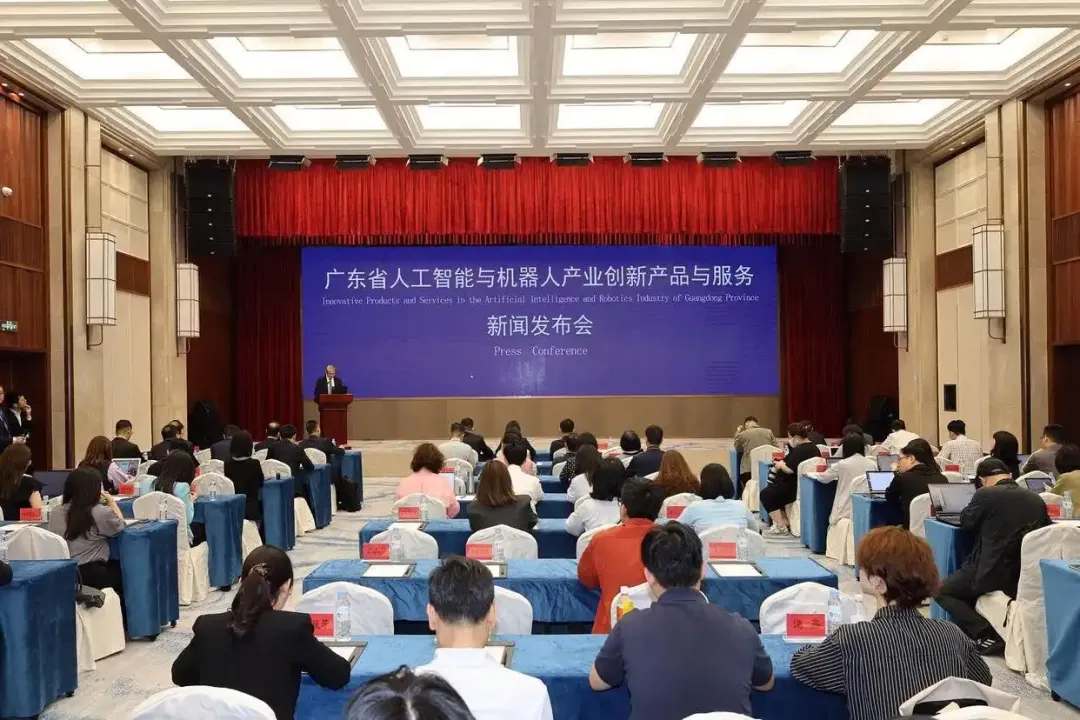On April 9, the press conference for innovative products and services in the artificial intelligence and robotics industry was held in Guangzhou, Guangdong Province, where eight major AI industry models, 30 AI application scenarios, 29 AI application solutions, and 13 smart terminal products were announced. Qu Xiaojie, Deputy Director of the Guangdong Provincial Department of Industry and Information Technology, pointed out that Guangdong is promoting innovative development in the AI and robotics industry, accelerating the establishment of a global hub for AI and robotics development.

Seizing the High Ground in the Development of AI Terminal Industry
Currently, driven by comprehensive upgrades in model, chip, and operating system sectors, AI technology is fully integrated into terminal products such as mobile phones, PCs, audiovisual devices, automotive systems, industrial applications, commercial products, and home appliances. This not only redefines the functional forms of terminals but also endows them with new capabilities such as proactive perception and understanding, multimodal natural interaction, intelligent services, and autonomous learning evolution. It has sparked a new revolution in terminal intelligence, comparable to the replacement of traditional feature phones by smartphones, profoundly impacting the electronic information industry and becoming a new focal point for global competition and a new opportunity for restructuring the global economic landscape.
Guangdong is a major global manufacturing base for electronic information products, with an expected revenue of 5.34 trillion yuan in the electronic information manufacturing industry in 2024, maintaining its position as the national leader for 34 consecutive years. The shipment volumes of mobile phones and televisions account for approximately one-third and two-fifths of the global market, respectively, contributing nearly half of the profits with about one-third of the national revenue, and accounting for 75.9% of the growth rate of the province’s industrial scale, effectively serving as a “ballast stone” to stabilize the province’s industrial economy.
Qu Xiaojie stated: “The Guangdong Provincial Party Committee and Provincial Government attach great importance to and actively study the challenges and opportunities posed by artificial intelligence to the electronic information industry, promoting the rapid development of the AI terminal industry and maintaining the advantageous position of the electronic information industry. The Provincial Department of Industry and Information Technology will continue to exert efforts from policy, technology, enterprise, platform, and application aspects to strive for the high ground in the development of the AI terminal industry.”
First, increase policy support. Coordinate various funds to tilt policies towards AI terminals, support localities in promoting the intelligent upgrade of existing advantageous industries, develop distinctive AI terminal products, build a number of AI terminal industrial parks, and promote industrial agglomeration development.
Second, vigorously develop AI chips. Continue to implement the “Guangdong Strong Chip” project, actively develop edge AI chips, support a number of high-end chip engineering R&D and industrialization projects, and strive for breakthroughs in the R&D and industrialization of key core products in high-end chips.
Third, solidify the open-source HarmonyOS technology foundation. Support AI terminal enterprises in adapting operating systems based on open-source HarmonyOS, construct a unified technical framework and interface specifications, integrate system components and toolchains, and promote the prosperous development of the open-source ecosystem.
Fourth, build high-level industrial platforms. Create innovation centers for AI terminal manufacturing, technology innovation centers, and other innovation platforms, support leading high-end enterprises in forming or participating in AI terminal industry alliances, and promote the R&D of common technologies in the industry, engineering breakthroughs, and the transformation of results.
Fifth, promote the application of AI terminals. Support industrial enterprises in actively using AI industrial terminals to enhance the digital and intelligent levels of manufacturing lines. Regularly select and publish lists of AI application scenarios and products, hold supply-demand matching activities by industry, and accelerate the landing of new AI technologies and products.
Preliminary establishment of a complete industrial chain for intelligent robots
The intelligent robot industry in Guangdong Province is mainly located in the Pearl River Delta, combining advantages in electromechanical technology and digital intelligence technology, characterized by a complete industrial chain, agile response, and rich application scenarios. It has a full industrial chain including complete machines, key core components, and system integration application providers, with high product reliability and significant advantages in the response efficiency of the industrial support system for R&D innovation. “Guangdong Province has initially established a complete industrial chain for intelligent robots covering the ‘brain – sensory organs – limbs,'” Qu Xiaojie stated.
In terms of the “brain,” Guangdong Province has nine general models including Huawei’s Pangu and Tencent’s Hunyuan, with regional innovation capabilities in the AI industry ranking first in the country for seven consecutive years. Leju has deep cooperation with Shenkai Hong to release two humanoid robots equipped with a “distributed heterogeneous multi-machine collaborative robot operating system based on open-source HarmonyOS.” The introduction of the HarmonyOS will promote the expansion of its application scenarios from single functions to deep cross-domain collaboration. Tuosida, based on the Euler operating system and cloud-edge architecture design, achieves software-hardware decoupling through virtualization and containerization technology, enabling deep integration of mainstream AI large models and simulation systems.
In terms of motion control, KUKA’s new generation intelligent controller platform is equipped with high-performance computing units to achieve real-time motion control of multi-axis coordination; through adaptive dynamic environment algorithms combined with vision and force control technologies, it enhances the flexibility and stability of robots in complex scenarios. Zhongqing Robot adopts a self-developed integrated harmonic joint module to build an advanced visual neural network system, combined with excellent reinforcement learning and imitation learning control schemes, achieving excellent motion performance such as front flips.
In terms of “limbs,” PAXINI has launched a dexterous hand for humanoid robots that integrates multi-dimensional tactile and AI vision dual modalities, capable of generating multi-dimensional tactile responses to improve fine manipulation capabilities. Moxian Technology has developed high-density, high-sensitivity, and wide-range electronic skin for humanoid robots, which not only enhances the tactile perception ability of robots but also features low cost, high stability, and strong scalability.
Strong R&D innovation capabilities, rich manufacturing application scenarios, and a favorable business environment provide unique conditions for the technological R&D and product landing of robot enterprises. The application of robots in Guangdong is significant and has broad prospects. KUKA focuses on heavy-duty industrial robots and has developed a series of products suitable for various tasks from welding to palletizing and assembly, with a maximum load of 800 kg, widely used in automotive manufacturing, metal processing, aerospace, electronics, and other industries. Industries such as home appliances, ceramics, and textiles in Foshan are actively introducing robots. Leju’s humanoid robot “Kuafu” has been delivered in bulk for applications in industrial manufacturing, commercial services, and scientific research education. GAC Group’s humanoid robot “GoMate” has entered the field testing stage and has great potential in security, health care, and automotive after-service markets.
Looking ahead, with the rising number of elderly populations, increasing labor costs, and the gradual maturity of robot technology, accelerating the application of robots in daily life has significant implications for the economic and social development of our country. Qu Xiaojie stated that Guangdong Province will vigorously promote the widespread application of “robot +” in the livelihood sector, focusing on medical health, elderly care services, education, and urban management services, selecting a number of application scenarios with high application value and promotion potential, using application scenarios as a traction to promote the iterative upgrade of robot technology, forming a robot innovation development ecosystem supported by technology, driven by scenarios, and deeply empowering the application of robots in key industries.
Building an Open-source Innovation Ecosystem for Artificial Intelligence and Robotics
On March 9, the General Office of the Guangdong Provincial People’s Government issued the “Several Policy Measures for Promoting the Innovative Development of the Artificial Intelligence and Robotics Industry in Guangdong Province,” proposing to support enterprises, universities, research institutes, and industry associations in jointly building open-source communities, open-source ecological centers, and related public service platforms for the field of artificial intelligence and robotics through technological collaboration.
Open-source is an open, shared, and collaborative innovation model that achieves multi-party collaborative innovation through a “gathering intelligence and strength” mechanism, significantly lowering technical barriers and integrating industrial resources. Guangdong Province attaches great importance to the construction of the open-source ecosystem, driving open-source development through policy empowerment, and has gathered millions of open-source developers, with companies ranking among the top ten global open-source enterprises.
It is reported that in the future, Guangdong Province will strengthen the construction of the open-source ecosystem through the following measures.
First, increase policy and financial support. Each year, no more than five high-quality open-source communities and ecological centers will be selected, and 30% of their approved operating expenses from the previous year will be subsidized, with a maximum support of 8 million yuan per project. This means that excellent open-source communities and ecological service organizations can receive substantial financial support from the government, effectively reducing the innovation costs for enterprises.
Second, multi-party collaboration and systematic efforts to strengthen the open-source ecosystem. Support enterprises, universities, research institutes, and industry associations in hosting AI and robotics-related exhibitions, forums, competitions, and developer activities to strengthen technology sharing and knowledge dissemination. Encourage enterprises and research institutions to co-build open-source communities related to the field of artificial intelligence and robotics.
Third, application-driven and demand-oriented, promote industrial application and commercialization. Actively promote enterprises to release open-source basic frameworks, empowering industries such as robotics, home appliances, and automobiles to construct open application scenarios, accelerating the industrial application and commercialization of open-source technologies. For example, combining open-source project products with specific industry vertical business scenarios in robotics, home appliances, and automobiles, providing project operation, scenario development, safety supply, cycle management, subscription support, and other professional services, or customizing solutions for other enterprises in need. In simple terms, achieving a virtuous cycle of “technology blood production” and “industry feedback.”
The Guangdong-Hong Kong-Macao Greater Bay Area combines the advantages of electromechanical technology and digital intelligence technology, possessing a complete industrial chain for artificial intelligence and robotics, with comprehensive support, quick response, high quality, good service, and a favorable ecosystem, making it a global hub for talent, technology, and capital. In the next steps, the Office of the Leading Group for the Innovative Development of the Artificial Intelligence and Robotics Industry in Guangdong Province will continue to coordinate resources, cultivate enterprises, promote industrial agglomeration, optimize ecosystems, and facilitate exchanges, supporting more AI and robotics enterprises in continuously breaking through in technology industrialization, product commercialization, and service commercialization, and continuously providing high-quality and cost-effective products and services, accelerating the empowerment of AI across various industries and deepening the application of “robot +” scenarios.
Scan the panoramic map, please follow the instructions below to download
Sharing Method
Please scan to join the editor WeChat (im202501), and note your city, industry, and name for a higher approval rate. After approval, the file will be shared with you, and you will also be invited to join the study group WeChat group.
Welcome everyone to join the manufacturing industry group for communication. Those who need to join the group can contact Colin WeChat (im202501).
The following industries can join: 1. Aerospace equipment; 2. Satellite manufacturing and application; 3. Rail transit equipment manufacturing; 4. Marine engineering equipment manufacturing, shipbuilding; 5. Intelligent equipment manufacturing; 6. Military equipment; 7. Heavy equipment, complete sets of equipment; 8. Engineering machinery; 9. Intelligent devices (robots, CNC machine tools, automated production lines, instruments, etc.);
